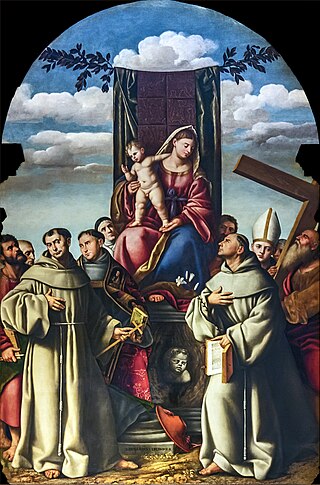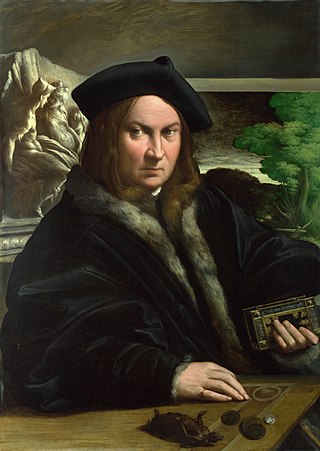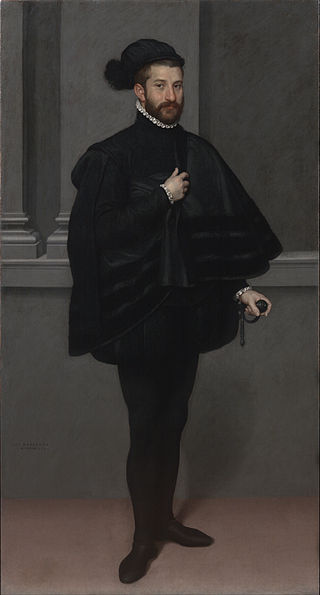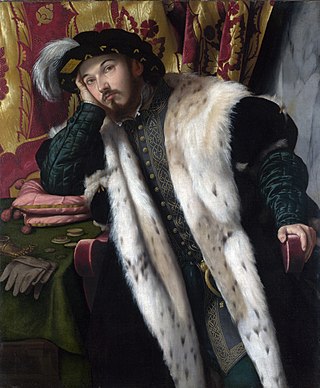
Giovanni Battista Moroni was an Italian painter of the Mannerism. He also is called Giambattista Moroni. Best known for his elegantly realistic portraits of the local nobility and clergy, he is considered one of the great portrait painters of the Cinquecento.
The Salimbeni Prize is awarded by the Fondazione Salimbeni per le Arti Figurative of San Severino Marche to honour excellence in the writing of art history on an Italian subject. The Premio Salimbeni was established in 1983.

Antonio Mancini was an Italian painter.

Bernardino Licinio was an Italian High Renaissance painter of Venice and Lombardy. He mainly painted portraits and religious canvases.

Portrait of a Collector is a painting by the Italian Mannerist artist Parmigianino, executed around 1524.

Giovanni Battista Ricci nicknamed Il Novara after his birth town, was an Italian painter of the late-Mannerist and early-Baroque period, active mainly in Rome.

The Tailor is an oil on canvas painting by Italian painter Giovanni Battista Moroni, from 1565-1570. It is a portrait of a member of the Marinoni family, who has been traditionally taken to be a tailor practising his art during the work day. The painting is held in the National Gallery, in London.

The Knight in Black is an oil on canvas portrait painting of an unknown male subject by Giovanni Battista Moroni, from c. 1567. It is held in the Museo Poldi Pezzoli, in Milan.

The Pralboino Altarpiece is an oil on canvas altarpiece, of 1540–1545 and measuring 356 x 225 cm, by Moretto da Brescia in the church of Sant'Andrea in Pralboino, Province of Brescia, Italy. The work's upper register shows the Madonna and Child with Francis of Assisi and Saint Joseph, whilst below are saints Jerome, Louis of Toulouse, Anthony of Padua, Clare of Assisi and the painting's commissioner, cardinal Uberto Gambara, member of a local family. It was originally in the same town's Franciscan church of Santa Maria degli Angeli.
Simone Facchinetti is an Italian art historian.

Mystic Marriage of Saint Catherine or Mystic Betrothal of Saint Catherine is a 1567-1570 oil on panel painting by Giovanni Battista Moroni, produced for the side-altar of Catherine of Alexandria in the church of San Bartolomeo, parish church of Almenno San Bartolomeo, where it still hangs. It is signed at lower right IO:BAP.MORONUS.P. The church had been begun in 1520 through the will of Giorgio Rota, but work lapsed until restarting in 1562. The painting draws on the composition of Moretti's 1539 Rovelli Altarpiece.

Count Guglielmo Lochis was an Italian nobleman, politician, art collector and art connoisseur.

The Portrait of a Woman with Mask is a pastel painting by the Venetian artist Rosalba Carriera, completed between 1720 and 1730. It is in the collection of the Palazzo Melzi d'Eril, in Milan. Its dimensions are 56 by 47 cm.

Madonna and Child with Saints is a c. 1520 oil on panel painting by Palma Vecchio, now in room XVI of the Accademia Carrara in Bergamo, the artist's birthplace. It is first recorded as part of the collection of Guglielmo Lochis, who acquired it in 1830 from Cristoforo Orsetti, one of the most important Venetian collectors of that era.

Portrait of a Courtesan or Portrait of a Woman is a c. 1520 oil on canvas painting by Palma Vecchio, now in the Museo Poldi Pezzoli in Milan.

The Portrait of Alessandro Vittoria is an oil on canvas painting created by Italian painter Giovanni Battista Moroni, in 1551–1552. It is held at the Kunsthistorisches Museum, in Vienna.

Portrait of a Lady, also known as The Lady in Red is an oil on canvas painting by Italian painter Giovanni Battista Moroni, from c. 1556–1560. It is believed to depict Countess Lucia Albani Avogadro, a 16th-century Italian poet. It is held in the National Gallery, in London.

The Knight in Pink is an oil on canvas painting by Italian painter Giovanni Battista Moroni, from 1560. It depicts a nobleman, Gian Gerolamo Grumelli, and is one of the artist's best-known portraits. It is held in the Palazzo Moroni, in Bergamo.

The Bergamasque and Brescian Renaissance is one of the main variations of Renaissance art in Italy. The importance of the two cities on the art scene only expanded from the 16th century onward, when foreign and local artists gave rise to an original synthesis of Lombard and Venetian modes, due in part to the two cities' particular geographical position: the last outpost of the Serenissima on the mainland for Bergamo and a disputed territory between Milan and Venice for Brescia.
Eugenio Riccomini was an Italian art historian. He died on 25 December 2023, at age of 87.

















